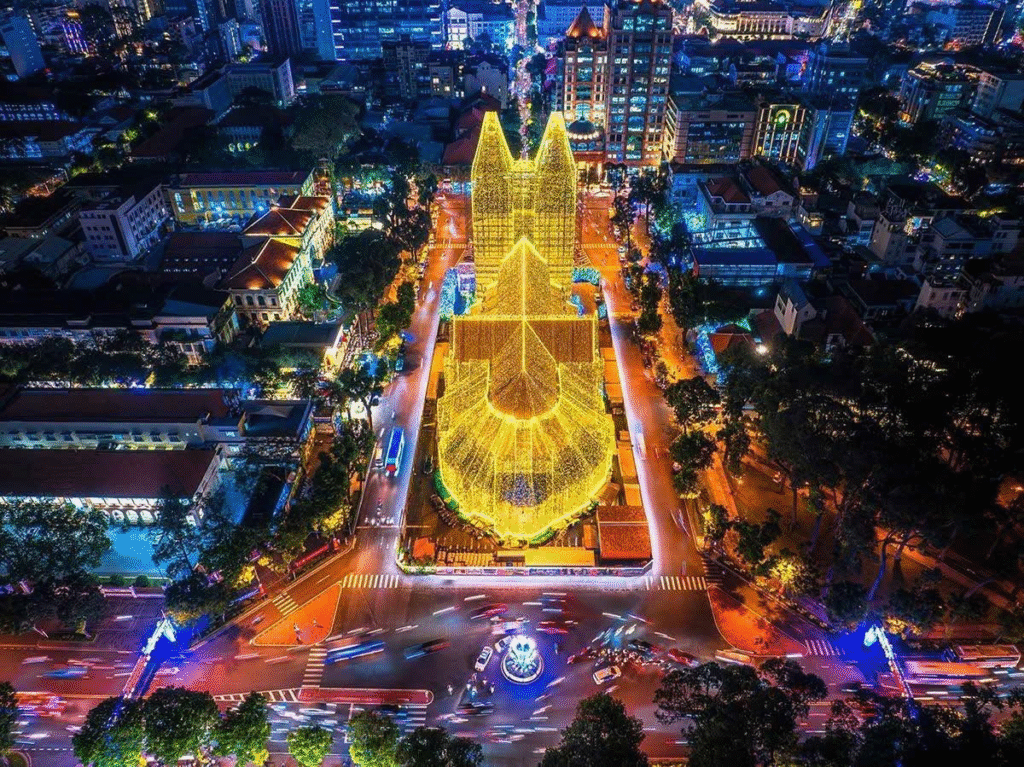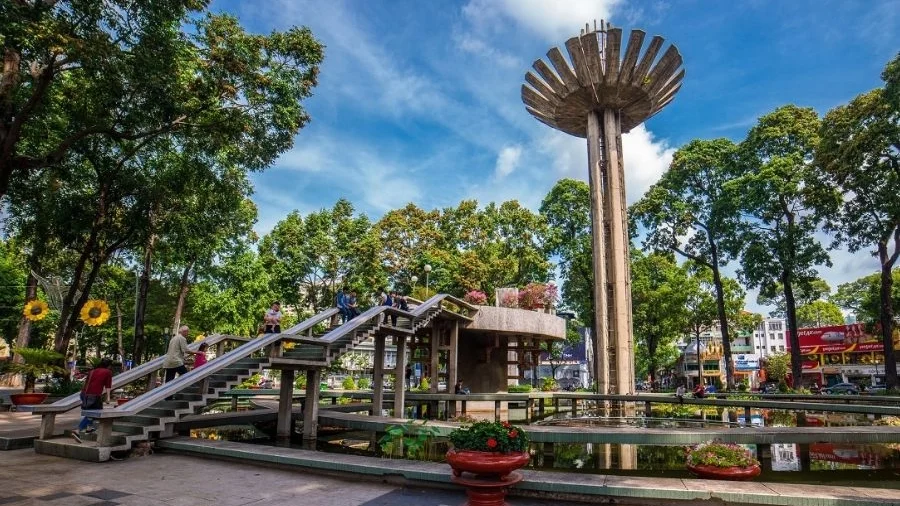Notre-Dame Cathedral Basilica of Saigon – A Historical and Architectural Landmark of Ho Chi Minh City

The Notre-Dame Cathedral, officially known as the Cathedral Basilica of Our Lady of the Immaculate Conception, is one of the most iconic and long-standing landmarks of Ho Chi Minh City. Located at Paris Commune Square in District 1, this architectural masterpiece is not only an attractive destination for tourists but also carries profound historical and cultural values.
General Information
The Notre-Dame Cathedral stands at Paris Commune Square, Ben Nghe Ward, District 1, Ho Chi Minh City.
The cathedral was built in the late 19th century during the French colonial period, when the colonial government intended to construct a large church to serve both the community and religious needs of the French administration and army.
The groundbreaking ceremony took place on October 7, 1877, under Bishop Isidore Colombert, and construction was completed in 1880. Designed by architect J. Bourad, the building combined Romanesque Revival with Gothic elements. All construction materials, from cement and steel to screws, were imported from France. The exterior was built with red bricks from Marseille, which remain fresh and moss-free even today. The cathedral also features 56 stained-glass windows made by Lorin of Chartres, France.

The cathedral’s foundation was specially designed to withstand ten times the weight of the entire structure. Unlike many churches of its time, Notre-Dame Cathedral was built without surrounding fences or walls, symbolizing openness and accessibility.
Inside, the nave consists of a central hall, two side aisles, and two rows of chapels. The cathedral measures 93 meters in length, 35 meters in width, and 21 meters in height, with a capacity of up to 1,200 people.
A Cultural and Historical Symbol in the Heart of the City
Spiritual Connection and Community Bond
Notre-Dame Cathedral is not only a place for daily worship but also a hub for major religious celebrations. Christmas, Easter, the Feast of the Blessed Virgin Mary, and other Catholic feasts are celebrated on a grand scale, attracting thousands of parishioners and visitors. These occasions create a vibrant spiritual atmosphere, where people gather to share joy, gratitude, and love.

For the local community, especially Catholic families, the cathedral is both a spiritual sanctuary and a cultural-social center. It has been a place of comfort, connection, and faith for generations. Beyond its religious role, the cathedral has become one of the most famous tourist attractions in Ho Chi Minh City, drawing visitors worldwide to admire its architecture and experience its unique spiritual ambiance.
Historical Milestones
- 1863 – 1880: Construction of Notre-Dame Cathedral took place under French colonial rule.
- 1880: The cathedral was completed and inaugurated, becoming one of the finest examples of Gothic Revival architecture in Southeast Asia.
- 1940s – 1950s: During World War II and post-war upheavals, the cathedral served as a spiritual refuge for many citizens.
- 1975: After the political transition of Saigon, the cathedral continued to stand as a symbol of faith and culture for the city.
- 1990s – 2000s: With Vietnam’s period of international integration, the cathedral grew into a popular tourist destination, promoting Vietnamese history and culture globally.
- 2017: A large-scale restoration project began to preserve the cathedral, with completion expected in 2027 (delayed from the original 2019 schedule)

Architectural Highlights of Notre-Dame Cathedral
The Basilica Interior

The interior structure is remarkable, designed to endure immense weight. Its layout includes a central nave, side aisles, and chapels. With its impressive dimensions—93 meters long, 35 meters wide, and 21 meters high—the cathedral can accommodate up to 1,200 people.
The Bell Towers

The bell towers are key highlights of the cathedral. Initially, the towers were 36.6 meters tall. In 1895, two 21-meter spires were added, bringing the total height to 57 meters.
The Altars and Stained Glass

The marble altars are another notable feature, accompanied by 56 colorful stained-glass windows depicting sacred biblical scenes. The architectural details blend Romanesque and Gothic styles, creating a solemn yet elegant space.
The Outdoor Park

In front of the cathedral lies a small park, a favorite gathering spot for locals and tourists alike. At its center stands the statue of Our Lady of Peace, sculpted by G. Ciocchetti in 1959. The statue, 4.6 meters tall and weighing 8 tons, was carved from Italian white marble and remains a striking landmark.
Conclusion
The Notre-Dame Cathedral Basilica of Saigon is more than just an architectural landmark – it is a timeless witness to the city’s history, culture, and spiritual life. From its 19th-century French colonial origins to its role as a center of faith and community today, the cathedral continues to embody both resilience and beauty. Whether admired for its striking Gothic-Romanesque design, its religious significance, or its role as a gathering place for generations, Notre-Dame Cathedral remains an enduring symbol of Ho Chi Minh City and a must-visit destination for travelers from around the world.


Leave a Reply